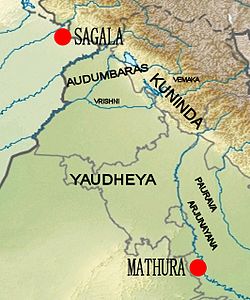225:
44:
They are native to
Eastern parts of Himachal. They claim themselves to be the descendants of Hill Rajas of an Ancient Kingdom. Ethnically and linguistically, Kanets residing in middle and lower hills of Himachal are of an Indo-Aryan stock such as other Rajput clans, but there are also mixed
224:
107:) Dynasty which once ruled the Parts of East Himachal and to Kumaun region of Uttrakhand for a very long time till the rise of Gupta Empire and before the arrival of Medieval Era(6thCE-12thCE) Rajput Clans
169:{राणा अमोघभूति}, who ruled in the mountainous valley of the Sutlej and Yamuna rivers (in today's southern Himachal and far western Uttarakhand in northern India around 200B.C.)
175:
One of the Edicts of Ashoka on a pillar is also present at Kalsi, in the region of
Garhwal, indicating the spread of Buddhism to the region from the 4th century BCE.
418:
172:
The Greek historian
Ptolemy linked the origin of the Kuninda to the country where the rivers Beas, Sutlej, Yamuna and Ganges originate.
178:
The
Kuninda kingdom disappeared around the 3rd century, and from the 4th century, it seems the region shifted to Shaivite beliefs.
54:
200:, i.e in districts like Mandi, Kullu, Sirmour, Shimla, Solan and Bilaspur with very few representation in Kangra and Hamirpur.
386:
7.1.42: ὑπὸ δὲ τὰς Βιβάσιος καὶ τοῦ Ζαράδρου καὶ τοῦ Διαμούνα καὶ τοῦ Γάγγου ἡ Κυλινδρινή, "and enclosed by the
428:
423:
116:
49:, Although during British times they were considered one of the agriculturalist castes of Himachal like
112:
197:
159:
30:
181:
Kanet
Thakurs/Rajputs could be the descendants of Ruling Ranas(Chieftains) of the Ancient
108:
46:
38:
132:
45:
Mongoloid-Tibetian stock of Kanets in
Kinnaur and Lahul. Kanet are known by the title
412:
163:
58:
166:
136:
124:
70:
34:
387:
250:
230:
242:
152:
148:
320:
246:
238:
182:
147:
chief named Subahu/सुबाहु' is mentioned in
Mahabharata who joined the
144:
140:
128:
120:
100:
399:
395:
391:
330:
325:
234:
50:
306:
131:.They were Defeated by the Arjuna. Kunindas are also mentioned by
41:.There is a major subcaste of kanets which is known as "Mukhiya".
26:
22:
99:
According to a theory of their origin Kanets are descendants of
37:
and allied activities. They also generally use as a
302:
288:
278:
266:
258:
210:
229:Location of Kuninda relative to other groups: the
196:are mostly found in central, eastern and southern
53:. The term agricultural tribe, according to the
362:A Glossary of the Tribes and Castes of Punjab
350:A Glossary of the Tribes and Castes of Punjab
119:from Central And North India. The Kingdom of
29: natively residing in the state of
8:
33:. Historically, Kanets have been engaged in
69:The modern Name "Kanet/kunet/Kunait" is an
223:
207:
158:One of the great kings of the Kuninda was
342:
364:. Low Price Publications. pp. 457–471
352:. Low Price Publications. pp. 457–471
287:
277:
273:
7:
57:, was at that time synonymous with
218:Before 2nd century BCE–3rd century
14:
419:Social groups of Himachal Pradesh
151:with his army and fought against
55:Punjab Land Alienation Act, 1900
84:Ku/कु changed to ka/क Or ku/कु
1:
204:Location of ancient Kunindas
87:ñi/णि changed to nē/णे/ने/नै
445:
298:
274:
222:
217:
373:Mazumder (2003), p. 105
290:• Disestablished
284:Before 2nd century BCE
123:is also mentioned in
90:Da/द changed to ta/त
280:• Established
312:
311:
436:
403:
380:
374:
371:
365:
359:
353:
347:
227:
208:
198:Himachal Pradesh
31:Himachal Pradesh
444:
443:
439:
438:
437:
435:
434:
433:
409:
408:
407:
406:
402:is Kylindrinē."
381:
377:
372:
368:
360:
356:
348:
344:
339:
317:
291:
281:
254:
213:
212:Kuninda Kingdom
206:
191:
155:in the battle.
97:
67:
12:
11:
5:
442:
440:
432:
431:
429:Punjabi tribes
426:
421:
411:
410:
405:
404:
375:
366:
354:
341:
340:
338:
335:
334:
333:
328:
323:
316:
313:
310:
309:
304:
300:
299:
296:
295:
292:
289:
286:
285:
282:
279:
276:
275:
272:
271:
268:
264:
263:
260:
256:
255:
228:
220:
219:
215:
214:
211:
205:
202:
190:
187:
96:
93:
92:
91:
88:
85:
66:
63:
25:found in
13:
10:
9:
6:
4:
3:
2:
441:
430:
427:
425:
424:Indian castes
422:
420:
417:
416:
414:
401:
397:
393:
389:
385:
379:
376:
370:
367:
363:
358:
355:
351:
346:
343:
336:
332:
329:
327:
324:
322:
319:
318:
314:
308:
305:
303:Today part of
301:
297:
293:
283:
269:
265:
261:
257:
252:
248:
244:
240:
236:
232:
226:
221:
216:
209:
203:
201:
199:
195:
188:
186:
184:
179:
176:
173:
170:
168:
165:
161:
156:
154:
150:
146:
142:
138:
134:
130:
126:
122:
118:
114:
110:
106:
105:कुणिन्द/कुणीद
102:
94:
89:
86:
83:
82:
81:
80:
76:
72:
64:
62:
60:
56:
52:
48:
42:
40:
36:
32:
28:
24:
20:
16:
383:
378:
369:
361:
357:
349:
345:
194:Kanet/Kunait
193:
192:
189:Distribution
180:
177:
174:
171:
157:
104:
98:
78:
74:
68:
59:martial race
43:
39:Thakur title
18:
17:
15:
294:3rd century
251:Arjunayanas
167:Amoghabhuti
137:Ashtadhyayi
125:Mahabharata
71:Apabhramsha
35:agriculture
413:Categories
398:, and the
337:References
259:Government
231:Audumbaras
384:Geography
382:Ptolemy,
243:Yaudheyas
65:Etymology
392:Zaradros
315:See also
262:monarchy
249:and the
247:Pauravas
239:Vrishnis
153:Kauravas
149:Pandavas
121:Kunindas
396:Diamuna
388:Bibasis
321:Rajputs
267:History
235:Vemakas
185:Tribe.
183:Kuninda
145:Kuninda
141:Kulinda
135:in his
129:Kulinda
117:Chandel
109:Chauhan
101:Kuninda
75:Kuninda
400:Ganges
394:, the
390:, the
331:Ghirth
326:Gaddis
270:
245:, the
241:, the
237:, the
233:, the
160:Rajnah
133:Panini
113:Parmar
95:Origin
51:Ghirth
47:Thakur
307:India
79:Kunid
27:India
23:caste
21:is a
19:Kanet
164:Rana
139:. A
127:as
77:or
73:of
415::
115:,
111:,
61:.
253:.
162:/
143:/
103:(
Text is available under the Creative Commons Attribution-ShareAlike License. Additional terms may apply.
